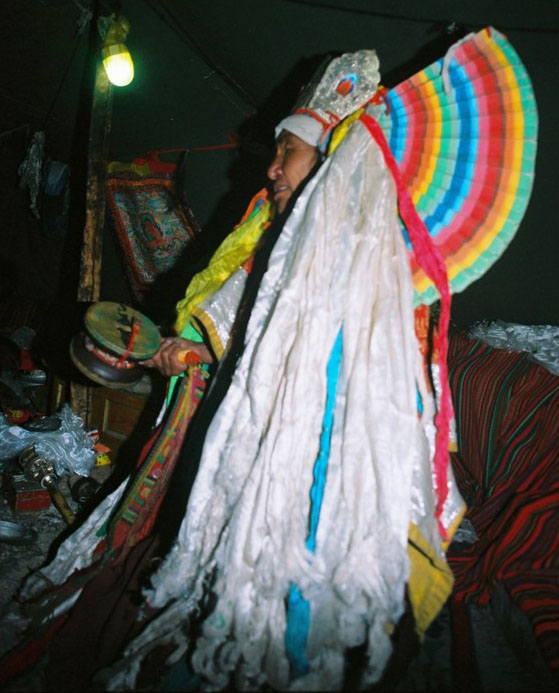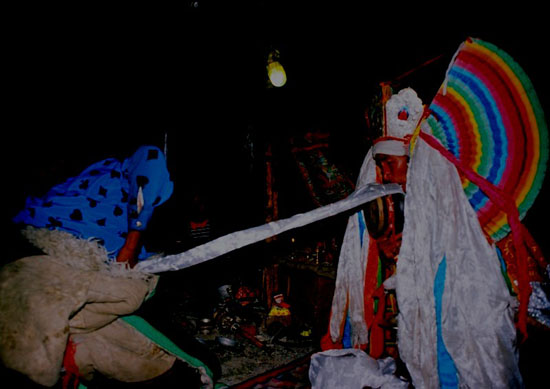
November 2009
John Vincent Bellezza
The ‘God’ Men and Women of Upper Tibet
Tracking the sun as it bends low in the northern hemisphere Flight of the Khyung goes on yet another adventure in Tibet. This month’s issue focuses on the spirit-mediums or shamans of Upper Tibet, that special group of men and women who purportedly embody, in body, speech and mind, the deities. Called lhapa, pawo, klumo, etc., those persons channeling the gods pursue a profession that has every indication of being of great antiquity, at least in its most elementary form. Direct communications between priests and deities is recorded in early historic Tibetan literature. While spirit possession does not appear to be explicitly mentioned in the Old Tibetan language documents, the cultural props supporting it are given much expression.
The tradition of spirit-mediumship thrived in the Tibetan upland far from major centers of Buddhism and Eternal Bon. Although it did find patrons even avid supporters among the clerical class, in more densely populated areas the tradition of household spirit-mediums encountered some ecclesiastic resistance. However, despite facing formidable obstacles from various sides, an indomitable group of spirit-mediums still carry on their hoary practices today.
In my 2005 book Calling Down the Gods, I announced that top spirit-mediums of Upper Tibet not appearing in that work would be given due attention in subsequent publications. In the mid-2000s, I did indeed interview several great practitioners at length, making audio records of their utterances during the trance ceremony. My research, exploration and writing schedule has been so full since that time I have not been able to dedicate myself to this ethnographic material, save for a paper I delivered at the 11th conference of the International Association of Tibetan Studies, in 2006. Eventually, I plan to write another book on the Upper Tibetan spirit-mediums.
The vocation of spirit-mediumship is marvelous and compelling, a special method of healing and prognostication with resonance the world over. The topic of trances and oracles in Tibet is sparking the imagination of an emerging generation of scholars. Not least of all with them in mind, I again pick up my pen on the subject. For the edification of readers, I shall introduce one more spirit-medium in this Flight of the Khyung. Please note that this lhapa appears under an assumed name.
Lha-pa Bon-nyid (Interviewed on September 23–25, 2005)
Lha-pa Bon-nyid is a charming and discrete family man in his middle years. He was born in the Rabbit Year (1951) to parents of the Hor clan and a much older clan native to Sekhor (bSe-’khor). His mother’s sister, a nun, was also a spirit-medium, as well as a disciple of the celebrated rNying-ma lama Degyal Rinpoche (bDe-rgyal Rin-po-che). Bon-nyid learned the ways of spirit-mediumship from Khampai Pachung (Khams-pa’i dPa’-chung), the late great shaman of the region (see Calling Down the Gods for an account of this formidable individual).
Bon-nyid first went into trance at the relatively late age of 25, that is, after the end of the Chinese Cultural Revolution. During the extremely trying times of the Cultural Revolution, traditional Tibetan and Chinese practices of all kinds were proscribed. Bon-nyid states that the primary reason for calling upon the deities is to heal the illnesses of those who seek him out. He carries out his work freely with no expectation of financial reward.
Bon-nyid is a spirit-medium for the Gyagar (rGya-gar) gods, Nyenchen Thanglha’s (gNyan-chen Thang-lha) circle, Nor-lha, and Atak Lumo (A-stag klu-mo). The Gyagar gods are a diverse collection of divinities of both native and Indic origins. The sundry spirits in this group belong to a system of classification inspired by epic literature and Buddhist doctrine. Nyenchen Thanglha is of course the most powerful mountain god of the eastern third of the Changthang, and a popular god of spirit-mediums throughout the Tibetan world. Nor-lha is a syncretistic figure combining elements of the Indian god of wealth Dzam-bha-la and native wealth-bestowing spirits of a zoomorphic persuasion. Atak Lumo is one of the heroines in the Ling Gesar (Gling ge-sar) epic, a female warrior of immense prowess and influence.
Before possession, Bon-nyid offers his heart, lungs and other organs to the presiding deities of the trance ceremony. This practice is derived from gcod, a radical Buddhist practice for quickly cutting through mental obscurations. In anticipation of being overtaken by the gods, Bon-nyid also invokes the mistress of the subtle energy channels of the body (rtsa-bdag) to take up residence at the threshold of his channels. He says that this enables the divinities to descend and enter into his body. Bon-nyid believes that at the moment of possession, his consciousness (rnam-shes) is conveyed into space and is under the care of the celestial gods (lha).
The trance ceremony I witnessed was convened at night in Bon-nyid’s black yak-hair tent. The tent was jam-packed with family members and neighbors. A simple altar for the ceremony had been erected in front of the family altar. The gling or main mirror of the ceremony was inserted upright into a bowl of barleycorn. Circular copper alloy mirrors, some many centuries old, are used to direct and shelter the deities of the trance.
That night preliminary prayers began at 21:35. For these invocations, Bon-nyid wore a simple white turban on top of his head and a brocade mantle over his shoulders. The spirit-medium said his initial prayers playing the hourglass-shaped hand-drum (da-ma-ru) and the flat-bell (gshang), standard instruments of his profession. The chanting was slow and deliberate, an occasion for those present to enter into a more thoughtful frame of mind, perhaps saying their own prayers in silence. The many deities invoked range from the Buddha himself to the epic hero Gesar to the ancient warrior spirits known as drabla (dgra-lha).

Lha-pa Bon-nyid chanting while in trance
Gesar in his form as a drabla was invoked with resolute and poetic language typical of epic literature and the ancient rituals of propitiation known as gsol-kha:
Kye! Kye! From the tent of the blue sky, from the realm of the encircling rainbow light, I offer incense to the drabla of the entire world. The lotus with miraculous activities, the manifestation of [King] Trisong Deutsen (Khri-srong lde’u-btsan), he who destroys the divisions of evil demons (bdud), is Great Lion Jewel Subduer of Demons (Gesar). You have the appearance of a reddish man with turquoise eyebrows; the appearance of dark reddish brown with fringes of coral. On your body you wear a robe of gold. On your head you don a silver helmet. The long-life knots of the drabla spungs se spung (conveys that masses of knots are converging). On your right side is a tiger-skin quiver. On your left side is a leopard-skin bow case. You tie Tabpa Lenme (the name of a sword) on your waist. You ride the mount Wild Onager Yer-ba. You are surrounded by circles of drabla and werma (another type of warrior spirit). Please come here and in accordance with your wishes receive meat and blood. To destroy the demon divisions of evil, you subdue enemies and obstructors through form and formlessness. Quickly carry out all activities!
At 21:58, Bon-nyid placed the five-lobed crown (rigs-lnga) on his head. Rainbow-colored fans (gshog-pa) were affixed to each side of this crown. These fans symbolize the descent of the consciousness of the deities, which is envisaged as a rainbow light. After placing his crown Bon-nyid began to chant again; this gradually built up in intensity to a fevered pitch. Six minutes later Bon-nyid jumped to his feet and started to dance while playing his instruments with much gusto. With the passing of seven more minutes, he started to growl, heralding the advent of the possessing deities, some of which are in the form of fierce carnivores. We later learned that the gods of the trance that night belonged to the Gyagar group. On our behalf, a petitioner (bka’-lung) approached the spirit-medium, requesting him to pronounce the fate of the Tibetan Upland Expedition, which was then in progress. To the relief of the crew, we received a clean bill of health from the gods. Like others expeditions before and after this one, there were formidable logistical challenges involved with traversing broad swathes of the Changthang. This little moral boost gratis the gods was very welcome, as far as we all were from our homes.

Bon-nyid sucking out disease-causing substances
After the oracular function of the trance, the curative session began in all earnest. It lasted just seven minutes. There were four patients, all local drokpas. Under the influence of his helping spirits, Bon-nyid used his drum and flat-bell to suck out disease-causing impurities from their bodies. He made a deep gurgling noise while carrying out this procedure. The last patient was a young woman clutching a baby. After each sucking session, the spirit-medium displayed a dark substance on his ritual instruments. This is understood to be the contamination removed from the patients. These impurities or grib are sometimes envisioned as being in the form of worms. There are believed to be many types of grib, each causing different kinds of sickness.
After attending to the sick, Bon-nyid returned to playing his instruments and chanting in an animated fashion. This is the period when the Gyagar horde begins its return to the heavens, the work here on earth finished for the time being. At 22:29, the crown fell from the head of the spirit-medium, signalling that the divine possession was over. Bon-nyid intoned a prayer of thanksgiving for his safety and the success of the proceedings. These face-to-face encounters with the gods are perceived as being momentous, even hazardous affairs, for no one knows for certain how they will react in any given situation. Slowly and without much discussion, those in attendance repaired to their own tents, marking the end of an extraordinary evening.